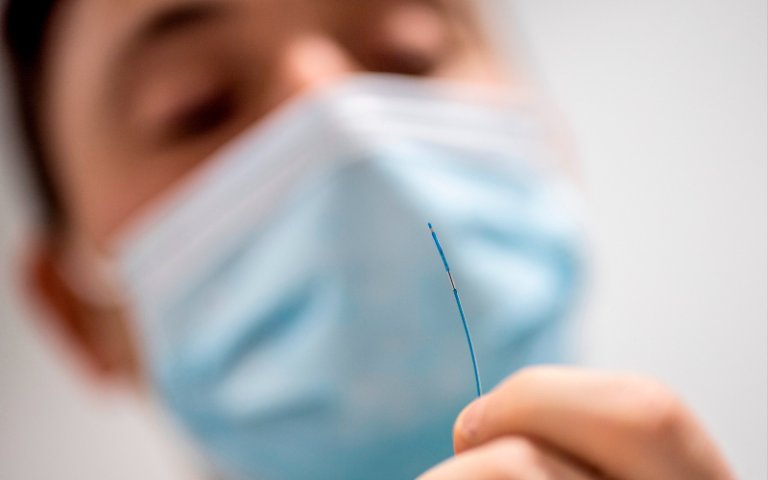First heart patients diagnosed using new fibre optic technology
21 February 2023
A new diagnostic technology, developed by scientists at UCL, that uses tiny fibre optic sensors to detect the causes of heart disease, more quickly and accurately than existing methods, has been used for the first time in patients.

The iKOr device uses an ultra-thin microcatheter integrated with fibre optic sensors and allows doctors to check both blood pressure and blood flow around the heart and look for signs of narrowing and thickening of the arteries – a common sign of disease.
It was developed by a team at UCL’s Department of Medical Physics & Biomedical Engineering, with assistance from collaborators at Queen Mary University of London. It has since been commercialised through Echopoint, a UCL spinout company.
The technology is now being trialled at Barts Health NHS Trust and so far, three patients have undergone a test for heart disease using the iKOr device. The slimline probe is particularly suited at detecting narrowing of the very smallest heart vessels, known as microvasculature. These tiny blood vessels do not show up well in the traditional X-rays (angiograms), which are typically used by cardiologists to image the heart’s larger arteries.
Lead iKOr developer, Professor Adrien Desjardins (UCL Medical Physics & Biomedical Engineering), and a co-investigator at the Wellcome-EPSRC Centre for Interventional and Surgical Sciences, said: “The iKOr device is responding to a clinical need – to significantly improve how blood flow in the heart is measured.
“Our microcatheter provides concurrent pressure and flow measurements from inside coronary arteries – this is unique and makes the tiny blood vessels more measurable, compared to traditional X-rays.
“This will help to significantly improve diagnosis and treatment for a large group of patients; those with obstructive coronary artery disease and coronary microvascular dysfunction.
“An increasing body of evidence shows the importance of accurate assessments of the coronary microvasculature in targeting therapies, which has particular relevance to women and diabetic patients who are more likely to have microvascular dysfunction.”
Having access to more accurate information on the health of a person’s heart will allow doctors to better decide what course of treatment to prescribe – medication, surgery or no surgery, or if the patient can stop their medication.
“In current clinical practice there is a potential for over diagnosis, resulting in invasive surgeries, such as stent insertion, that comes with risk and can take time to recover from," added Professor Desjardins.
“Being able to more accurately diagnose heart disease, particularly microvascular disease, will mean more patients can be treated with specific tailored drugs that would not be prescribed without a diagnosis.”
The iKOr device has a temperature and pressure sensor that is just 0.2mm wide — or twice the thickness of a human hair — which is threaded through the patient’s blood vessels on an ultra-thin catheter.
It measures the flow rate around the heart by flashing a brief pulse of light upstream of the vessels under investigation, which warms the blood there by about one degree. The sensor detects the time taken for the temperature to change downstream, from which the device can tell whether the flow is obstructed by narrowing of the vessels.
However, before it can be widely used by doctors, researchers need to assess whether the device works safely and easily in patients. The first patient tests, carried out at St Bartholomew’s Hospital, London, confirm all these qualities – it is safe for patients, easy to use and works.
Professor Anthony Mathur, lead researcher for this work, based at St Bartholomew’s Hospital and Queen Mary University of London said: “I am pleased to say that we have successfully used this technology in patients for the first time. This new device is a game changer in how we manage heart disease, making it a lot easier to assess the health of a person’s heart. I look forward to progressing this research and hopefully, seeing it benefit more and more people in east London and beyond.”
Dr Malcolm Finlay, Honorary Associate Professor at UCL Medical Physics & Biomedical Engineering, and a consultant cardiologist at St Bartholomew’s Hospital said: “It’s an incredible highlight of my career to see a technology that we invented in the hospital and university being used for the first time.
“It shows the real, tangible benefit that collaboration between NHS hospitals and universities can have for patients my colleagues and I see day in, day out. And it’s a great example of why it’s important to carry out research in the NHS. Thank you to the patients who have agreed to be involved in this research and everyone who believed in our vision."
Among the first patients to trial the iKOr was Margaret Green, 75, who has angina and experiences shortness of breath. Speaking on her experience, Ms Green said: “It was a strange feeling but not uncomfortable. And I found out that I have something I’d never thought about: microvascular disease. “It’s brilliant that this research is being carried out in the NHS.”
The current clinical trial is designed as a ‘proof of principle’ study and will see 10 patients diagnosed using iKOr. This will be followed by a larger clinical trial to further show that the device is safe and works better than existing tests.
Researchers say it could eventually help many thousands of patients suffering from cardiovascular symptoms such as chest pains, whose cause cannot be identified with current techniques.
Links
- Professor Adrien Desjardins’ academic profile
- Dr Malcolm Finlay’s academic profile
- UCL Medical Physics & Biomedical Engineering
- Wellcome-EPSRC Centre for Interventional and Surgical Sciences at UCL
- Echopoint
- Queen Mary University of London
- Barts Health NHS Trust
Image
- Credit: Financial Times and Charlie Bibby, published on February 3, 2023
Media contact
Dr Matthew Midgley
E: m.midgley [at] ucl.ac.uk
 Close
Close

